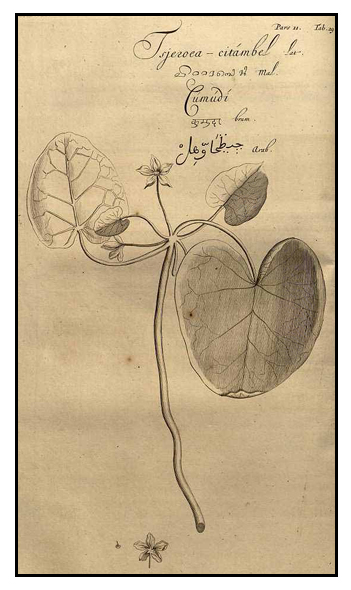 Plant pearls Plant pearls
- Crested floating heart is dicotyledonous aquatic plant that exhibits nymphaeid growth. Nymphoides probably derives from this botanical feature i.e., the plant is rooted in the submerged sediment and produced floating leaves at the ends of long stems. (4)
- The plant is aggressive and potentially invasive, capable of outcompeting native vegetations by forming dense floating canopies. (4)
Botany
Pusong-lutang is a perennial water plant of the habit of the water lily, producing carpet growth on surfaces of ponds or lakes. Stems are long and slender on the underside of floating leaves, rooted in submersed sediments or hydrosoil in shallow water. Plant can also be free-floating with tuberous propagules on the underside of leaves. Leaves are rounded, heart-shaped, 2.5 to 7.5 centimeters wide, and on long stalks. Flowers are white but yellow on the base. Corolla lobes are 6 to 8 millimeters long, and the tube bears a ring of white hairs around the throat. Fruit is a somewhat rounded capsule, and contains 10 to 20 seeds.
 Distribution Distribution
- In shallow lakes, quiet streams, and sometimes rice paddies, at low and medium altitudes; however, ascending in Mount Data to an altitude of 2,100 meters.
- Sometimes cultivated in ponds or as an aquarium plant.
- Also found in India to Southern China.
Constituents
- In a study for various antioxidant substances, Nymphoides cristata yielded
polyphenols 3.82 ± 1.02 mg GAE/g DW, flavonoids 23.28 ± 0.54 mg QUE/g DW, flavonols 6.71 ± 0.44 mg QUE/g DW. Anthocyanidins were not detected. (6)
- In a study for flavonols content in acidic hydrolysates, N. cristata yielded in quercetin 116.53 ± 26.66 µg/g DW, myricetin 1099.85 ± 37.03 µg/g DW, morin 3869.54 ± 213.27 µg/g DW, and kaempferol 107.41 ± 5.35 µg/g DW.
(6)
Properties
-Studies have suggested hepatoprotective and antibacterial properties.
Parts used
Stalks, seeds and leaves.
Uses
Edibility
- Plant reportedly used for food; probably the roots and pseudostems.
Folkloric
- In India, stalks and leaves are pounded with oil and applied to ulcers and insect bites. Also, used as a substitute for Valeriana hardwickii in neurological disorders and colic.
- Decoction used as wash for parasitic skin complaints.
- Seeds eaten to destroy or prevent intestinal worms.
- Reported use for fever and jaundice.
Studies
• Hepatoprotective / Roots: Study evaluated a hydroalcoholic extract of roots of Limnanthemum cristatum for hepatoprotective activity against CCl4 induced hepatotoxicity in male Wistar rats. The root extract significantly increased total protein and antioxidant enzymes, catalase and reduced glutathione, and improvement in lipid peroxidation. Silymarin, a known hepatoprotective drug, was used as standard for comparison. (2)
• Antibacterial: Study evaluated the antibacterial activity of four aquatic macrophytes viz., Najas graminea, Nymphoides cristata, Myriophyllum tuberculatum and Utricularia stellaris collected from the Purulia district of West Bengal. N. cristata showed activity against one gram-negative bacteria, Vibrio parahemolyticus. (5)
• Antioxidant: Study for DPPH activity and TEAC values in acid methanolic hydrolysates and ethanolic extracts yielded DPPH scavenging activity IC50 34.01 ± 0.11 µg/mL,
and TEAC-methanolic and TEAC ethanolic µmol Trolox/g DW of 47.80 ± 2.84 and 6.12 ± 0.25, respectively. ORAC (oxygen radical absorption capacity) was 129.32 ± 8.00 and 175.86 ± 1.09 µmol Trolox/g DW for hydrophilic and lipophilic ORAC, respectively. (see constituents above) (6)
• Antioxidant Activity / Polysaccharide Content: Study evaluated the antioxidant activity, total polysaccharide content and optimum extraction conditions for pseudosstems, roots, and leaves. Results showed 80% ethanol extract of leaves had the best antioxidant activity and pseudostems showed the most polysaccharide content. Antioxidant activity was attributed to polyphenols or flavonoids. (7)
• Phytoremediation / Chromium and Cadmium: Limnanthemum cristatum commonly grows in closed water bodies in India. In a study of absorption of chromium and cadmium, treated leaves showed highest accumulation of chromium at 2 ppm after 168 h. Concentration was greater in the root (060 µg/g dry wt) than the leaf ( 620 µg/g dw). For cadmium, highest accumulation was 0.1 ppm for both root and leaf. Results suggest the possibility of using the plant for reducing chromium and cadmium levels in polluted waters. (8)
Availability
Wild-crafted.
|

![]()



 Plant pearls
Plant pearls Distribution
Distribution